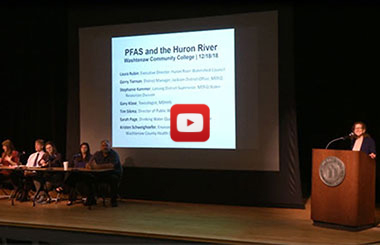Over 200 residents of Washtenaw County and nearby communities gathered at Washtenaw Community College on December 18th to learn about PFAS in the Huron River and hear about updates since the first meeting in Milford. Once again, experts from MDEQ, MDHHS, the City of Wixom, the City of Ann Arbor, The Washtenaw County Health Department, and HRWC answered questions from the audience.
You can view the slides presented at the meeting here. Or take a look at the video tape of the meeting (below).

Ann Arbor draws 85% of its drinking water from the river, so for those of us that live or work in town, PFAS pollution hits us right in the tap. Many studies have also come out since the Milford meeting in October that further detail the health risks of PFAS, show us the challenge is broader than originally thought, and confirm our concern that existing health advisories are inadequate.
The good news is that actions taken since October have reduced PFAS pollution from a major source to the river by about 92%. The existing levels are still way above the acceptable limit, but the early indicators show there are effective treatment options, and pollution levels from that major source will likely continue to fall as residue in pipes and other systems is flushed out over time.
Perplexing, however, is that PFAS levels in Ann Arbor’s drinking water supply increased even as pollution from Wixom decreased. No one knows why. It’s unclear if the spike in Ann Arbor’s source water was temporary, if it was driven by weather, or if there are other sources up river. Needless to say, everyone is very interested in solving that mystery, and DEQ discussed their plans to try and identify or rule out other potential sources.
Other questions from the audience were wide-ranging. As in Milford, the audience was respectful, thoughtful, and attentive. The idea that PFAS contamination has been in our water for years is distressing. That there is still no federal regulation is frustrating. Despite the anxiety all that creates, many audience members were eager to support policies that help state and local institutions solve the problem.
The discussion highlighted three points:
- Thanks to the work of state and local partners, we now have a clearer picture of PFAS contamination in the watershed. MDEQ testing has been extensive. The City of Ann Arbor has been proactive, going beyond what’s required by law to understand what the next threats may be.
- We need context and extensive research. We are rapidly learning more about the numerous ways PFAS pollution can harm us, but we have no context for testing humans or what to do once people are exposed. If a resident’s blood tests high for PFAS, for example, what does that mean? What can be done? Right now there is no good answer for what to do with that information.
- We need comprehensive, enforceable drinking water standards that hold polluters accountable and protect public health. On the same day that state experts released a report that says our PFAS health advisory levels are inadequate, state legislators jammed through bills in the lame duck session that would significantly weaken pollution protections for Michigan residents.
Cleaning up PFAS will require constant pressure from citizens on state and local officials to establish stronger PFAS regulations that put health and the environment first. For those looking for a way to help, call your state representatives, the Governor, and your municipal leaders regularly. Tell them we need stronger protections from PFAS.
You can learn more by visiting our PFAS webpage here.
The Michigan Department of Environmental Quality has been continually updating a comprehensive webpage through the Michigan PFAS Action Response Team (MPART).



